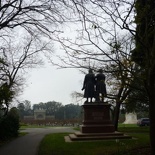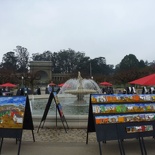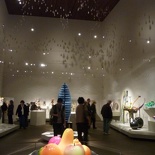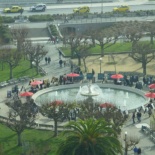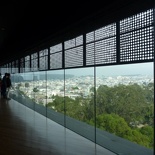Golden gate park and de Young Museum
Golden Gate Park in San Francisco is a large 412 hectare rectangular urban park located on the north western part of the city. Comprising mostly public park grounds and lakes, it is over 5km long spanning east to west, about a kilometer north to south in height, bounded by Lincoln Way on the south, Fulton Way on the north and Carl Street on the eastern side. It is about 20% larger than the New York Central Park and is the third most visited public recreational city park in the United States after Central Park itself and the Chicago Lincoln Park.
The Conservatory of Flowers (Link: Conservatory official website)
The park has few major roads serving the innards of the park, one of them being the John F Kenndy Drive. Just off the road on the eastern entrance is The Conservatory of Flowers. The Conservatory is a California Historical site and a San Francisco Designated Landmark as listed on the National Register of Historic Places and the California Register of Historical Places.
It is essentially a wooden greenhouse and botanical garden housing a collection of rare and exotic plants in the Golden Gate Park itself. It was completed in 1878 and remains the oldest building in the whole park. It is also one of the first municipal conservatories constructed in the country, giving it the title as the oldest municipal wooden conservatory remaining in the United States.
A large open lawn flaunts the front of the Conservatory, sadly which is devoid of the iconic flower patches as seen blooming in the summer. Large community planter grounds can be seen on the sides of the Conservatory which is surprisingly busy in mid winter too. Entrance to the Conservatory is a payable $7 and there is free admission on the first Tuesday of every month.
The Music Concourse
The Music Concourse is an open-air plaza and park within the Golden Gate Park itself. It forms the central grounds for events complete with large open dirt areas decked with Heavily pollarded trees. The venue is popular with the locals for exercise (especially Tai-chi with the large asian population here in the mornings), gatherings and fairs. The concourse sits in between the California Academy of Sciences and Deyoung Museum with the Music Concourse drive running along it’s perimeter.
The concourse was originally built for the California Midwinter International Exposition of 1894, where it underwent significant redesigns thereafter to suit it’s new purpose as a venue for public gatherings centered around music performances. The Bandshell, also known as the Spreckels Temple of Music is the main highlight her and is the landmark of the concourse, it was completed in 1900 and is a focal point for musical performances at the park over the last century.
California academy of sciences (Link: Official academy website)
Moving deeper into the park will bring you to the Music Concourse section of the park, this concourse is home to the sculpture and statue section of the park together with few iconic landmarks and museums. One of the here is the California academy of sciences, Steinhart Aquarium and Morrison Planetarium sitting on the south east side of the concourse.
The California Academy of Sciences, rebuilt in 2008 is among the largest and newest natural history museums in the world. The academy have it’s humble beginnings in the 1853 as a learned society and is a site for education and on-going research in various science fields, namely biology, astronomy and natural history.
The large museum grounds is home to to the Kimball Natural History Museum, featuring an African Hall comprising of largely animals from where else, Africa, a four-story dome emulating a tropical rainforest as well as a Foucault pendulum. The exhibits on display here are frequently rotated and updated to cover a variety of subjects relevant to the place. The astronomy part of the facility is the Morrison Planetarium, devoted to all things astronomically planety and stary. Last but not least is the Steinhart Aquarium, which is completely underground and very much occupies most of the basement area. The facility still carries out a large amount of original research, with exhibits and education becoming significant endeavors of the museum in the twentieth century and beyond.
Several sculptures line the interior of the park, completely complimented with gothic looking looking trees (London plane and Scotch elms). The statues here includes representations of Ludwig von Beethoven, Guiseppe Verdi, Ulysses S. Grant, Junipero Serra as well as a monument dedicated to Francis Scott Key. A Roman Gladiator overlooking the Music Concourse in front of the De young museum commemorates the excavation of the Music Concourse in 1893.
De Young Museum (Link: Official museum site)
Opened in March 24, 1895, the De young Museum is a Fine and contemporary Arts museum decked out brown with an Egyptian style building which spots a seemingly modern architectural design way ahead of it’s time. Located in along the Hagiwara Tea Garden Drive in the park just off the Music Concourse, the museum as an outgrowth of the California Midwinter International Exposition of 1894, which kinda mimics the previous year’s Chicago World’s Columbian Exposition which it was blatantly modeled off.
Entry to the museum requires a payable fee of $11 for adults and discounted rates for students and seniors, just remember to bring some ID and a student card for the student rate of $7. Entrance includes access to the museum’s top floor observatory on the Hamon Tower which I will cover later in this post. Now onto the museum collections!
The de Young Museum is home to over a thousand paintings, 800 sculptures, and 3000 decorative arts. The main lobby of the museum’s pretty minimalistic and you start off the galleries right into a modern art gallery featuring rather bizarre blobs of paintings as well as sculpture made out of everyday scrap items. There was even a rather neat looking cathedral compete made out of gun parts, teeth and a spine bone, totally astonishing. The galleries move on to more traditional galleries of glassware and pottery before entering into another international contemporary and expressionist art section. Here you have access to the stair well to the upper floor of the museum and the entrance to the early American art gallery and artifacts.
The early American art on the ground floor comprises mainly of rather interesting looking figurines and tribal pieces from the Indians in the early days. Moreover, the museum offer regular guided tours at specified timings, so it pays to check out these timings at the museum’s reception if you intend to know more about the exhibits covered. These tours are usually conducted by volunteers or the museum staff themselves. The tours may be section specific and may or may not cover the whole museum grounds themselves.
Besides offering bird eyed views of the lower galleries and the Osher Sculpture Garden, the upstairs is home to more traditional art, particularly Victorian styled paintings and early furniture, with a number of them donated by the residents of San Francisco themselves. Much of the older art archives of the museum can be found up here to, namely art of the Americas, the Pacific with the whole floor devoid of contemporary art. Many of the showcased American art dates back from the 17th through the 21st centuries, comprising mainly of painting, sculpture and furniture. It’s from the overlooking windows of American galleries where you can get an overview of the giant iconic blue paper clip in the outdoor sculpture garden.
The arts of Africa is one of the main galleries up here on the upper floor. It’s decked out in a rather dark woody atmosphere to go with tribal displays. Having said that, the galleries spot lots of tribal ware, ranging from boats to tools of the trade to shrunken heads, weapons, wood sculptures and cravings just to name a few. Together with the textiles and costumes gallery, it occupies a major gallery on the upper floors directly accessible via the main stairway from the museum’s ground lobby. This staircase is also where the tour of the museum ends from the upper floor, bringing you right back down to the reception area. The basement of the museum is home to the cloak room which provides complimentary storage of bulk equipment and bags as they are not allowed in the galleries with fear of damage to the displays. The basement’s also home to the special galleries which are usually traveling temporary displays requiring a separate entrance fee.
Finally, a good way to end the trip to the museum is a trip to the Hamon Tower.
The Hamon Tower is a twisting 44m tall observation tower, sprouting out of the east end of the De Young’s main museum building as viewed from the Music concourse. It is accessbile by lifts and provides a full unobstructed views of the Music concourse, the north bay residential areas of the San Francisco city as well as the Osher Sculpture Garden directly below the tower. It’s not a rather tall tower to begin with, so don’t be expecting overlooking scenic views of the city of San Francisco from here like that offered by the Twin Peaks. The museum’s giftshop is also located up here and sells a range of museum specific gear, as well as aerial maps of the city which will be useful up here.
Generally, the museum is good for 2-3 hours, which leaves the rest of the day to explore many of the other attractions the Golden gate park has to offer. The Japanese Tea Garden is no exception either.
Japanese Tea Garden (Link: Official website)
The Golden gate Japanese Tea Garden is oldest public Japanese garden in the United States and started out as a temporary exhibit during the World’s Fair (California Midwinter International Exposition of 1894) held at the music concourse. It was not when the brain child of the gardens- Makoto Hagiwara, a Japanese immigrant and gardener who approached John McLaren (superintendent of the Golden Gate Park) with the idea to convert the exhibit into a permanent park.
And so he did, Hagiwara personally oversaw the construction and planting of the Japanese Tea Garden as well as the official caretaker of the gardens from 1895 to 1925. The gardens span about 2.0 hectares in size and is now still a popular feature of Golden Gate Park. The gardens feature many native Japanese and Chinese plants, a teahouse to well, have tea in as well as many Asian sculptures, manicured decorate plants, Koi ponds, all served by laid paths and pond bridges all in a small little spot of tranquility.
It was through these gardens where the first evidence of fortune cookies in the United States was discovered, through the descendants of Makoto Hagiwara laying claim to introducing the fortune cookie to the United States from Japan. As a tradition, visitors to the garden were served fortune cookies made by a San Francisco bakery, Benkyodo. Even the road by the gardens are named after Hagiwara for his contributions.
Botanical Gardens (Link: Official site)
Not too far off from Hagiwara road is the San Francisco Botanical Garden. Laid out in the 1890s, and formerly known as the Strybing Arboretum, the establishment is a large botanical garden located right here in the heart of the San Francisco’s Golden Gate Park. It’s huge, spanning a total of 22.3 hectares complete with ponds, rivers and is home to over 50 thousand individual plants. A nice redwood forest trail resides here with particular focus on Magnolia species plants, together with high elevation palms and cloud forest species from Central America, South America and Southeast Asia just to name afew. The Botanical gardens is also home to the Helen Crocker Russell Library, northern California’s largest horticultural library.
The park itself is also home to few large lakes, such as the Stow Lake, the Spreckels Lake. The Golden Gate Park Stadium resides here too. Finally, the western end of the golden gate park is home to the Dutch windmill, just off the coastal beach with it’s front facing the Pacific ocean. The windmill is one of the two primarily built here in 1902 (with the other being the Murphy’s Windmill located south of the park) to pump ground water supply to the park. They were shortly replaced by electric pumps and now restored for historical purposes.
That’s all for the Golden Park Park then, lets get a move on to another museum in San Fran.
- Chilling out in the city of San Francisco (Pier 39, Fisherman’s Wharf) (Photos: City Album)
- San Francisco Cable Car Museum, Palace of fine arts and Exploratorium
- Up the Twin peaks and the Castro district, San Francisco (Photos: Twin Peaks & Castro)
- Golden Gate Bridge and Fort Point (Photos: Golden Gate Bayside)
- Golden Gate Park and Deyoung Museum (Photos: Golden Gate Park & De Young)
- Legion of Honor Museum (Photos: Legion of Honor Album)
- On the Alcatraz (The Rock) (Photos: Alcatraz Album)




